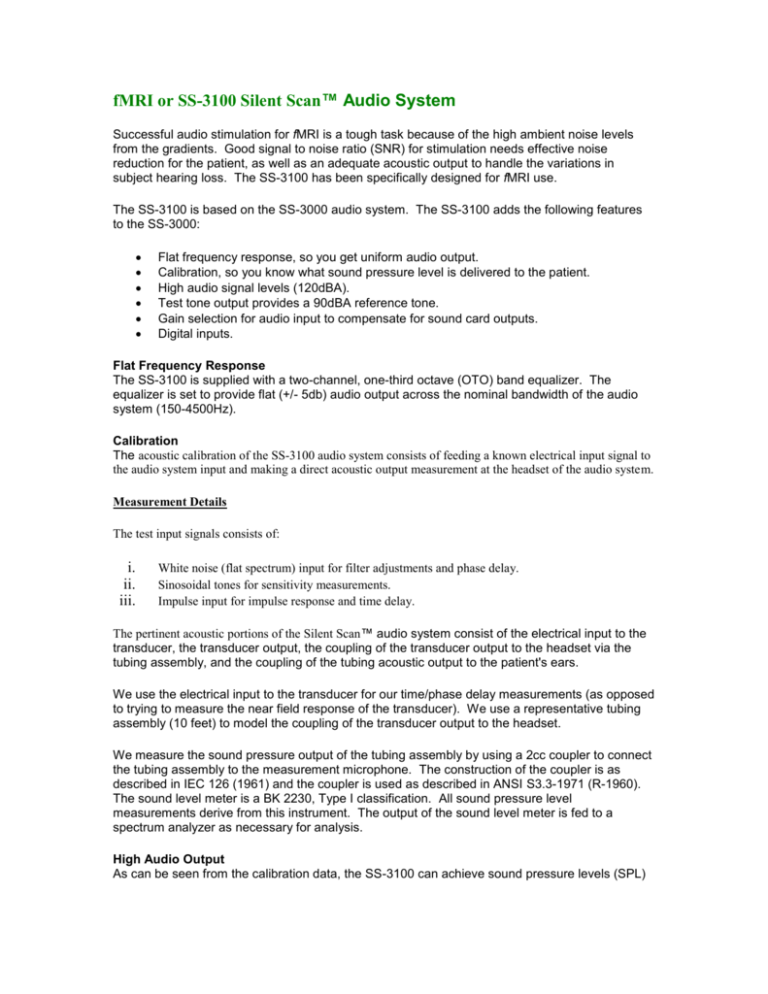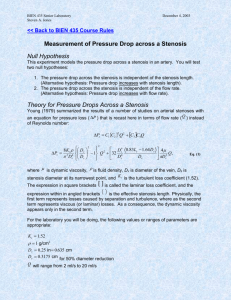
fMRI or SS-3100 Silent Scan™ Audio System
Successful audio stimulation for fMRI is a tough task because of the high ambient noise levels
from the gradients. Good signal to noise ratio (SNR) for stimulation needs effective noise
reduction for the patient, as well as an adequate acoustic output to handle the variations in
subject hearing loss. The SS-3100 has been specifically designed for fMRI use.
The SS-3100 is based on the SS-3000 audio system. The SS-3100 adds the following features
to the SS-3000:
Flat frequency response, so you get uniform audio output.
Calibration, so you know what sound pressure level is delivered to the patient.
High audio signal levels (120dBA).
Test tone output provides a 90dBA reference tone.
Gain selection for audio input to compensate for sound card outputs.
Digital inputs.
Flat Frequency Response
The SS-3100 is supplied with a two-channel, one-third octave (OTO) band equalizer. The
equalizer is set to provide flat (+/- 5db) audio output across the nominal bandwidth of the audio
system (150-4500Hz).
Calibration
The acoustic calibration of the SS-3100 audio system consists of feeding a known electrical input signal to
the audio system input and making a direct acoustic output measurement at the headset of the audio system.
Measurement Details
The test input signals consists of:
i.
ii.
iii.
White noise (flat spectrum) input for filter adjustments and phase delay.
Sinosoidal tones for sensitivity measurements.
Impulse input for impulse response and time delay.
The pertinent acoustic portions of the Silent Scan™ audio system consist of the electrical input to the
transducer, the transducer output, the coupling of the transducer output to the headset via the
tubing assembly, and the coupling of the tubing acoustic output to the patient's ears.
We use the electrical input to the transducer for our time/phase delay measurements (as opposed
to trying to measure the near field response of the transducer). We use a representative tubing
assembly (10 feet) to model the coupling of the transducer output to the headset.
We measure the sound pressure output of the tubing assembly by using a 2cc coupler to connect
the tubing assembly to the measurement microphone. The construction of the coupler is as
described in IEC 126 (1961) and the coupler is used as described in ANSI S3.3-1971 (R-1960).
The sound level meter is a BK 2230, Type I classification. All sound pressure level
measurements derive from this instrument. The output of the sound level meter is fed to a
spectrum analyzer as necessary for analysis.
High Audio Output
As can be seen from the calibration data, the SS-3100 can achieve sound pressure levels (SPL)
on the order of 120 dBA. High SPLs, under controlled and monitored fMRI experiments, can be
useful in two ways.
First, high SPLs may be necessary for effective stimulation of hearing impaired subjects.
Second, the stimulus SNR may be increased by utilizing the additional SPL dynamic range of the
SS-3100. SNR is increased by using secondary hearing protection means (such as earplugs) to
reduce the ambient (gradient) noise heard by the subject; the concomitant decrease in stimulus
SPL can be overcome simply by increasing the SPL output of the SS-3100.
Test Tone
The SS-3100 can output a fixed 1 kHz tone at a nominal 90 dBA sound pressure level. This can
be used as a useful reference signal.
Gain Selection
Sound cards that are used in may fMRI applications (particularly laptop based systems) do not
have adequate signal levels to drive the SS-3100 audio system to its full capabilities. The
necessary signal levels are on the order of 1Vrms. The SS-3100 has an output setting with a
10dB gain to compensate for this.
Digital Inputs
The SS-3100 accepts a fiber optic SPDIF input.
Technical Specifications SS-3000/3100
Music / Audio Inputs
Silent Scan TM accepts music input from any high quality stereo system with CD, cassette and AM / FM
sources. Computer generated inputs may also be used for functional MRI studies.
Silent VisionTM
Silent ScanTM is fully compatible with Avotec's Silent VisionTM fiber optic visual presentation system for
fMRI, MRI and MEG.
OEM
Avotec offers full design and manufacturing capabilities for MRI related accessories. We invite
your inquiry.
Components
Communication console with gooseneck microphone, transducer/electronics housing, cabling and
connectors between console and housing, two types of patients headsets, one ten foot ScanLockTM tubing assembly, patient alarm system with rubber squeeze bulb and ten feet of plastic tubing, and
stereo interface box.
Physical
Console, 7"H x 5"W x 8"D, 3 lbs.; Gooseneck Microphone, 17"; Transducer Housing, 4"H x 6"W x
3"D, 13 oz.; Transducer Cable, 200 feet (max); Stethoscopic Headset with silicon rubber eartips,
0.7 oz.; Full Coverage Headset, 13 oz.; 10 Foot Tubing Assembly, 19 oz.; Stereo Interface Box,
2.5"H x 2.5"W x 2"D, 4 oz.; Stereo Interface Cable, 15 feet.
Electrical
110V AC, 1Amp, fused; 220V AC version available.
Cabling
Transducer and Cable Interface Cables, 4 shielded twisted pairs; Power Cord, 3-wire grounded, 9
feet.
Colors
Housings: pearl white; Cables: gray.
Specifications subject to change without notice.
Avotec, Inc.
603 N. W. Buck Hendry Way
Stuart, FL USA 34994.
Telephone (772) 692-0750 Fax (772) 692-0788
avotec@avotec.org
www.avotec.org
©Copyright 2001-2005, Avotec, Inc. All Rights Reserved.










